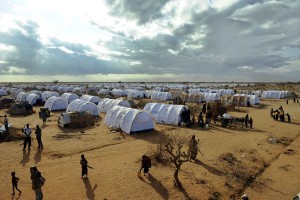By
DADAAB REFUGEE CAMP, Kenya — Nafiso Mohamed Noor says she never wants to go back to Somalia. But if the Kenyan government follows through with its plan to close the world’s largest refugee camp by the end of the year, she may not have a choice.
Noor knows what it means to return prematurely to a war zone. In May 2015, after Kenya renewed what has become a perennial threat to shutter the sprawling, windswept settlement on its northeastern frontier that houses more than 326,000 refugees, most of them from neighboring Somalia, she decided to sign up for the U.N.’s voluntary repatriation program. Better to go back on her own terms than risk being rounded up and deported without warning, she thought.

So in August, after waiting three months for the U.N. refugee agency (UNHCR) to process her application, she boarded a flight to the Somali capital of Mogadishu. She found her old house in Wardigle, a neighborhood whose name in Somali roughly translates to “stream” — or “channel” — “of blood,” still standing. But less than two months later, a mortar fired by al-Shabab militants crashed into her kitchen. The round sheared off her right breast, sliced a 3-inch gash in her left foot, and left shards of metal embedded deep in her left hip.
“The shrapnel is still there,” she said recently, tracing a faint crescent shape near the ball of her femur on an X-ray taken here in Dadaab. “There, it looks like a moon.”
Noor returned to Dadaab as soon as she recovered from her injuries, but she once again faces the prospect of repatriation to Somalia before the war there is over. In May, the Kenyan government said it planned to close Dadaab for good, along with another refugee camp along its northwestern border that houses nearly 200,000 mainly South Sudanese refugees, citing security concerns. Since it invaded Somalia in 2011 to create a buffer zone against the growing al-Shabab threat, Kenya has seen a dramatic surge in domestic terrorist attacks. The government claims that some of the worst attacks, including those at the Westgate Mall in Nairobi in 2013 and at Garissa University College last year, were planned in Dadaab, although it has never produced any evidence to support this.
But unlike previous threats to shutter the camp, the government followed this one up with action. It disbanded its Department of Refugee Affairs in May and later announced a plan to move 150,000 people out of Dadaab by the end of the year through a combination of voluntary repatriation, relocating non-Somali refugees, and removing Kenyans who falsely registered as refugees from the UNHCR’s rolls. The government has not addressed the discrepancy in numbers — nearly 200,000 people would remain in Dadaab even if the government succeeds in relocating 150,000 — or explained how the camp would be closed if some or most of its inhabitants decide they wish to remain behind.
If Dadaab were actually to be emptied by the end of 2016, the exodus would rival the massive forced relocation of Rwandan refugees registered in Zaire, now Democratic Republic of the Congo, after that country was invaded by Rwanda in 1996. And according to experts, it would almost certainly violate international law, which prohibits the forceful repatriation of refugees. Even the voluntary repatriation process currently underway could fall into a legal gray area, some experts argue, since many refugees fear they will be forcefully uprooted or are struggling to survive on limited food rations in the camp.
Read more: The World’s Largest Refugee Camp Is Invited to Please Shut Down
Source: FP



